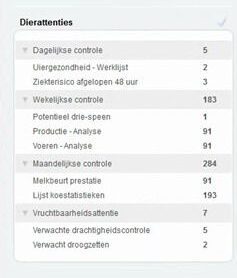Tip of the Month – December 2025
How long does it take to increase or decrease concentrates?
Many livestock farmers and feed consultants are still unclear about how DeLaval DelPro works with increasing or decreasing concentrates. After calving, it’s often clear, but especially after adjustments to the feed tables, things can go wrong. The default setting for increasing concentrates is 0.250 kg per day, and the default decrease is 0.150 kg per day. However, the latter is often adjusted to 0.100 kg per day.
Suppose a cow should receive 3 kg less concentrate, it will take her 30 days to do so. The feed table will then ignore this cow during these 30 days. This is fine for some cows, but often they are receiving too much concentrate for too long.
At many farms, I often add a column to their favorite Feed Control list that shows how many days a cow still needs to increase or decrease her concentrate intake.
How do you do that?
Go to your favorite Feed Control List. If it’s a “custom list,” you’ll see a triangle in the top bar. Clicking it will open a small window on the right. Find “Feeding.” Then “Ration.” Among the many options, you’ll also see “Target Days.” Drag this to your list.
It will then ask you which feed type you’re referring to. If you have multiple feed types, you can choose; of course, the feed type that changes most is the most important.
Just refresh the list, and the days will appear. Sort by these, and you’ll see which cows will still take the most days to build up or reduce their feed intake.
If it’s correct, leave it as is; if it’s not, double-click on the cow and adjust “Feeding” to what you think is a good plan for this cow.
This gives you even more control over the correct amount concentrate feed for each cow!
